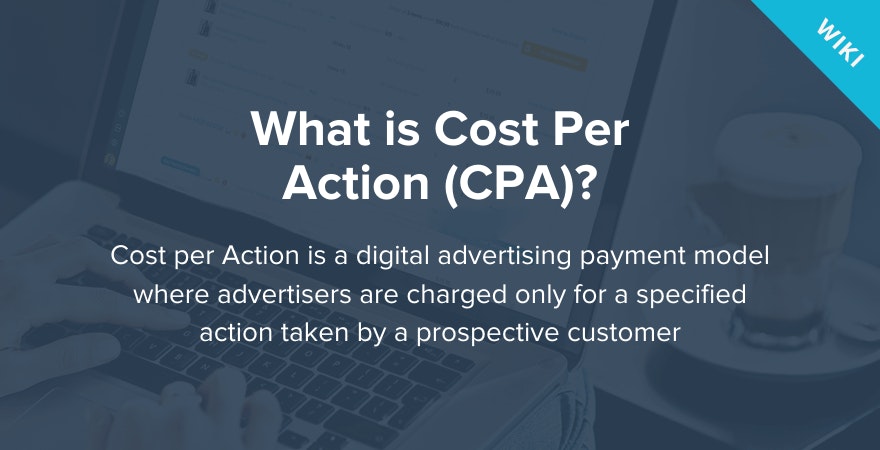
Cost Per Action (CPA)



What is Cost Per Action (CPA)?
Cost per action is a digital advertising payment model that allows to charge an advertiser only for a specified action taken by a prospective customer. All actions covered by the model are directly related to some type of conversion, ranging from a newsletter sign up to a link click or sale, and determined by the advertiser.
Cost Per Action vs. Cost Per Acquisition
Although the terms are often used interchangeably, cost per acquisition is a financial metric that measures the costs of acquiring one paying customer.
Cost Per Action(CPA) vs. Cost Per Click (CPC)
Cost per click (CPC) measures the cost or cost-equivalent for each click on your ads, while cost per action (CPA) allows you to determine the action (views, leads or sales) you want to measure. CPC is designed to drive traffic to a website whereas CPA includes various conversion related actions.
Cost Per Action (CPA) vs. Cost Per Lead (CPL)
Cost per lead (often called “online lead generation”) is an online advertising metric used to measure the cost of generating qualified sales leads. CPL helps to identify prospective customers who have shown intent to buy and are close to the end of the buyer journey, whereas cost per action is designed to measure all types of conversion related actions across the entire customer journey.
Why is Cost Per Action Important?
Cost per action allows advertisers to control advertising costs for specific marketing objectives, as it is designed to only charge for the ad when a chosen action is completed. With the payment for the ads being based on completed actions, it also gives the advertiser better control of tracking and maximizing the return on investment across different marketing channels. Tracking CPA ensures that you’re investing in the most cost-effective channels as well as helping to gauge the success of various marketing efforts.
How to Calculate CPA
Formulas used to calculate cost per action can get quite complex, but the most basic approach is: CPA = Total marketing spend (month/year) divided of Total number of customers acquired
The more touchpoints before a conversion are required, the more expensive is the acquisition. To calculate your CPA for every marketing channel, use figures appropriate to that particular channel (for example, if you spend $100 on Facebook ads and acquire 10 new customers, your CPA would be $10 per new acquisition for Facebook channel only).
How to Track Cost Per Action
Since payment of cost per action campaigns is made on the basis that an action is delivered, tracking is of paramount importance. For eCommerce stores, the most commonly used tracking methods include:
- Google Analytics: you can track your conversions by using appropriately tagged links that indicate source, medium and campaign. Depending on the action you want to track, you can also experiment with implementing a tracking code on a “thank you” page (this is most commonly used to get an accurate count of completed downloads or subscriptions).
- Voucher codes: especially effective with email and social media campaigns, voucher codes that shoppers enter at checkout are an easy-to-implement and cost-effective tactic adopted by the majority of online retailers.
How to Optimize Cost Per Action
Cost per action becomes really handy once you figure out how much a certain customer’s action is worth to your business. This helps to set the right advertising budget and continue to optimize to lower cost per action costs until you know that your marketing campaigns are paying off.
Steps to optimizing your cost per action:
- Fine-tune your CPC campaigns: to increase the number of conversions, you have to be absolutely sure your CPC campaigns are targeting the right audience and clearly communicating the value of the offer to entice people to click through to the landing page.
- Obsess about CRO: once a new visitor lands on the dedicated page, the first impressions and user experience are critical. The messaging on the landing page has to be in tune with the ad text that captured visitor’s attention and all the on-site content and design ought to work in harmony to lead the user to the conversion point. Employ A/B testing to refine the essential elements on your landing page and improve the conversion rate.
- Set up multiple goals: even if your ultimate goal is for a user to purchase something, setting up additional goals, such as time spent on the site or the number of pages visited, will give you a better insight into possible issues with your landing page. If users are spending time browsing your website, maybe the landing page isn’t compelling enough or they need more social proof to make a purchase. Whatever it is, you can fix it!



Want to Learn More?
- 10 Actionable Tips From Proven Facebook Marketing Experts
- Anyone Can Advertise on Google AdWords and Here’s How
- Facebook Ads Tactics That’ll Skyrocket Sales!
- The Complete Guide To Marketing Channels
Is there anything else you’d like to know more about and wish was included in this article? Let us know!